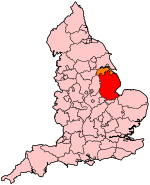Gainsborough (UK Parliament constituency)
| Gainsborough | |
|---|---|
|
County constituency for the House of Commons |
|

Boundary of Gainsborough in Lincolnshire for the 2010 general election.
|
|

Location of Lincolnshire within England.
|
|
| County | Lincolnshire |
| Electorate | 73,795 (December 2010) |
| Major settlements | Market Rasen and Gainsborough |
| Current constituency | |
| Created | 1997 |
| Member of parliament | Edward Leigh (Conservative) |
| Number of members | One |
| 1885–1983 | |
| Number of members | One |
| Replaced by | Gainsborough and Horncastle and Boothferry |
| Created from | North Lincolnshire |
| Overlaps | |
| European Parliament constituency | East Midlands |
Gainsborough is a constituency in Lincolnshire represented in the House of Commons of the UK Parliament since 1983 by Edward Leigh, a Conservative.
The constituency was created under the Redistribution of Seats Act 1885 that year, which lasted until it was reformed as Gainsborough and Horncastle on a boundary change for the 1983 election. That seat lasted until 1997, as from the mid nineties population changes led to removal of Horncastle from the seat and recreation of the old seat with largely similar boundaries.
1885-1918: The Municipal Borough of Lincoln, the Sessional Divisions of Epworth, Gainsborough, and Lincoln, and the civil parish of Bracebridge.
1918-1950: The Urban Districts of Crowle and Gainsborough, and the Rural Districts of Gainsborough, Isle of Axholme, and Welton.
1950-1983: The Urban Districts of Gainsborough and Market Rasen, and the Rural Districts of Caistor, Gainsborough, Isle of Axholme, and Welton.
1997-2010: The District of West Lindsey, and the District of East Lindsey wards of Binbrook and Wragby.
2010-present: The District of West Lindsey, and the District of East Lindsey ward of Wragby.
This constituency is named for its largest town of Gainsborough in Lincolnshire, on the west edge of the constituency, and comprises the West Lindsey district, and the Wragby ward of the East Lindsey district.
This relatively vast rural seat north of Lincoln is named after the small market town at its western boundary. Regeneration projects are attempting to reduce pockets of severe deprivation in the constituency, but most of the area is affluent, albeit remote from many major cities, the closest conurbation is the city of Lincoln to the immediate south. Though arable farming dominates the landscape and noteworthy pig farming industry, see Lincolnshire sausages, agriculture is in decline and the service/creative sector dominates. The seat has elected Conservative MPs since 1924 and is a stronghold.
...
Wikipedia
